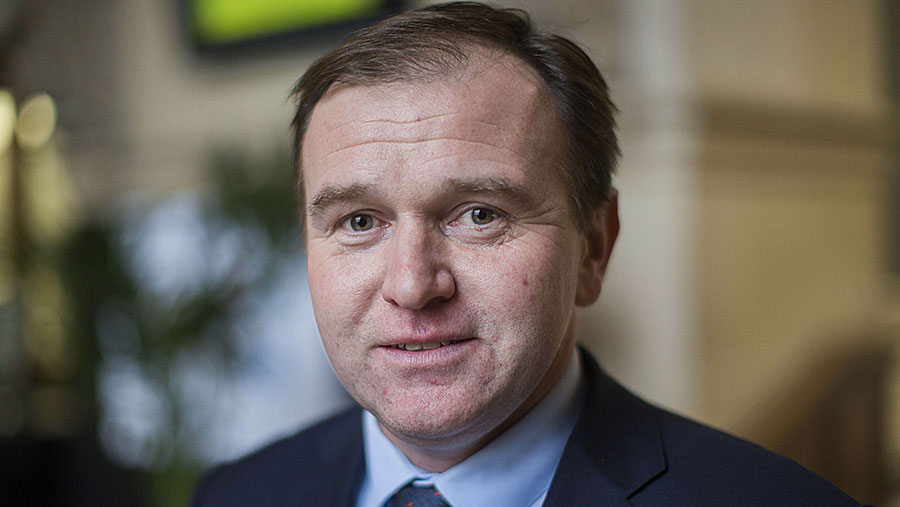Farm minister explains purpose of bovine TB review
 © David Hartley/REX/Shutterstock
© David Hartley/REX/Shutterstock The government has announced a review of its 25-year strategy to tackle bovine TB in England, which includes culling badgers to curb the disease.
Farm minister George Eustice said tackling the disease in wildlife is necessary to control TB in cattle, but “no one wants to be culling badgers forever”.
Mr Eustice said the independent review is not a review of the rationale behind the badger cull, but it will help establish what has and hasn’t worked to help inform future policy.
See also: Defra launches review of bovine TB strategy
George Eustice letter in full
Bovine TB has always been a difficult disease to fight. It is slow moving and insidious, as well as being difficult to detect – and no diagnostic test is perfect. It exists in the environment and within the wildlife population at large.
Vaccines are less effective against bacterial diseases such as TB than they are against viruses and decades of research into human TB has yet to find a more effective vaccine than the BCG, which only provides limited protection.
There is no one single intervention that provides a magic answer. Instead, we need to pursue a range of options to tackle the challenge.
Four years ago, Defra published the first draft of a 25-year strategy to eradicate the disease and make England officially bovine TB free.
Multi-pronged approach
The strategy outlined a broad range of interventions, including improving diagnostic tests, removing infected cattle from herds, tough movement restrictions on herds that suffer a breakdown, controlled culls of badgers in areas where disease is rife, improved biosecurity on farms, vaccination of badgers in the edge area and research and development into developing an oral vaccine for badgers and a deployable cattle vaccine.
Now is a good time to review progress and identify what steps might be needed to ensure we are ready to progress some of the interventions envisaged for later phases of the 25-year strategy.
We anticipate the government will conduct further reviews at five-yearly intervals to maintain progress towards our objective.
We know from our own history that we can achieve success. In the mid-1930s, approximately 40% of cattle herds were infected by TB.
As a result of cattle testing and movement restrictions and badger culling, the disease was eventually rolled back to a very low level by the late 1970s.
We can defeat this disease again but we have to accept it is a long-term endeavour. Valuable time was lost because of the unwillingness of Tony Blair’s government to expedite decisions 18 years ago.
No further delays
As a result, the task is now greater. When fighting diseases, even a slow-moving disease like TB, you need to act in a timely manner. You can’t dither and delay.
The cornerstone of our current policy is cattle testing and movement restrictions.
We have annual herd testing in the high-risk area, four-yearly testing in the low-risk area, plus a comprehensive regime of pre-movement testing, post movement testing, contiguous testing and radial testing where this is deemed necessary to mitigate the risk of disease spreading between farms.
We have recently introduced a harsher interpretation on cattle tests and are rolling out greater use of the more sensitive interferon gamma blood test.
We have also recently consulted on introducing an even greater frequency of testing at six-monthly intervals and recognition for farmers who take steps to protect their own farm and improve biosecurity.
The badger cull is a contentious part of the strategy but the veterinary advice is clear that it has a role to play in suppressing the spread of the disease.
Badger cull impact
Early analysis of the first two cull zones suggests that it is having the sort of impact history suggests we should expect with the incidence of the disease down by 21% in Somerset and 58% in Gloucestershire – within the range that is typical in previous trials.
However, we have never suggested that the badger cull alone will be the answer and no one wants to be culling badgers forever.
Our 25-year strategy envisages other interventions such as cattle vaccination, improved diagnostics, a focus on genetic resistance and other steps all potentially playing an important role in later phases of the strategy.
We need to assess now whether we are doing all we can to ensure such interventions are ready to go at the required time.
That will be one of the areas that will be considered by our review.
We also need to consider whether there are other measures and interventions, not identified in the original strategy that might be worthy of further consideration and we need to establish how best to evaluate the measures and interventions we are currently making.
The review we have announced will be led by Professor Charles Godfray, a population biologist and Fellow of the Royal Society and will conclude later this year.
It is a chance to look at all the elements of our strategy and take stock of progress.
